HK exhibition shows shared culture
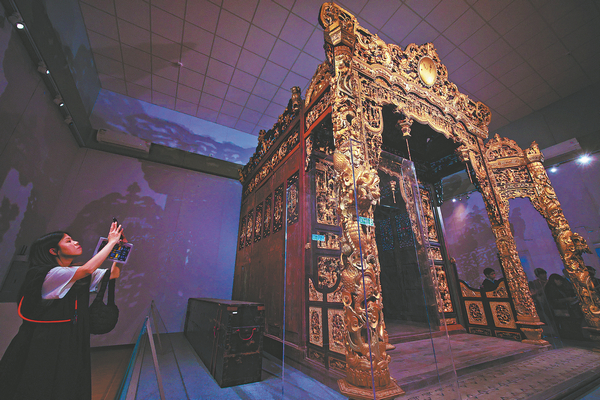
The exhibition features invaluable items and a shrine considered as a national treasure. CALVIN NG/CHINA DAILY
Bernadette Linn Hon-ho, secretary for development, says this exhibition is an important project jointly conceived, planned, and promoted by the Development Bureau and the National Cultural Heritage Administration, bringing together cultural resources from the Guangdong-Hong Kong-Macao Greater Bay Area.
She adds that it is the first project following the signing of two significant documents last year: a framework agreement to further promote cultural heritage exchange and collaboration on archaeology and built heritage between the mainland and Hong Kong, as well as a MOU between Hong Kong, Macao and Guangdong to jointly promote a culturally vibrant Bay Area under the Outline Development Plan for the Guangdong-Hong Kong-Macao Greater Bay Area.
Linn says that the exhibition's title reflects the continuity between the Lingnan traditional architectural culture in the Greater Bay Area and the Central Plains culture, embodying the integrated diversity of Chinese culture.
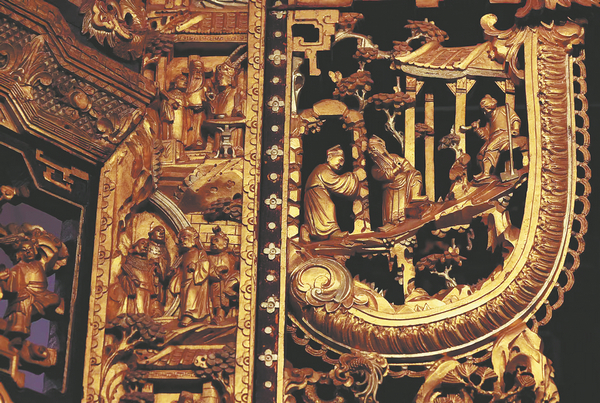
The Panyu shrine, one of the art pieces on display at the Under the Same Roof: Origin and Art of Lingnan Traditional Architecture exhibition at the Hong Kong Heritage Discovery Centre on Dec 12. CALVIN NG/CHINA DAILY
Four years ago, Hong Kong's Antiquities and Monuments Office, upon seeing photos of the Panyu shrine, was determined to bring it to Hong Kong for public viewing.
However, due to height restrictions of the exhibition hall at the Hong Kong Heritage Discovery Centre, preparations had to be put on hold. Eventually, a temporary exhibition hall was specially constructed in March this year to accommodate the shrine, she explains.
Logistics were also a challenge, since the shrine was stored in separate parts in a warehouse in Guangzhou, with a total of 160 components, each with its own storage box.
Huang expresses admiration for the Hong Kong government's determination, and the efforts involved in packaging, transporting, and reconstructing the exhibit, which required significant manpower and resources.
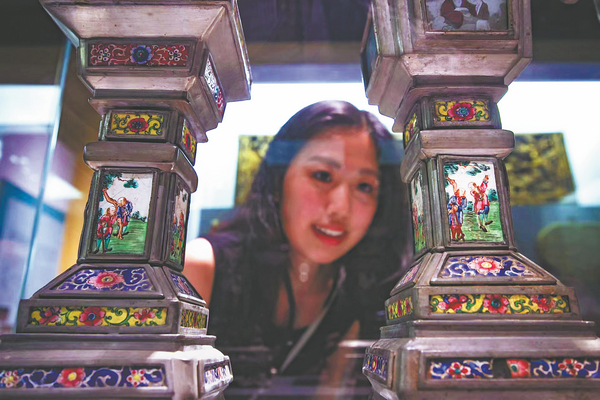
A visitor is captivated by the distinctive Lingnan architectural features of the exhibits. CALVIN NG/CHINA DAILY
During the transportation of cultural relics between the two places, both parties ensured that the removal company took proper safety and security precautions. After being transported to Hong Kong, it took almost a week to assemble the components before the exquisite artwork could be displayed in its entirety for the people of Hong Kong to appreciate.
Co-organized by the Development Bureau, the National Cultural Heritage Administration, and the Secretariat for Social Affairs and Culture of the Government of the Macao Special Administrative Region, the exhibition, which will run until June 2, includes Lingnan building components and archaeological finds.
"The brick and tile carvings of Lingnan culture possess consistency. You will discover during the exhibition that each brick and tile comes from different locations in Guangdong, Hong Kong, and Macao," Huang says.
A prime example of that theory is that the similarity shared between the two end tiles on the eaves. One from the Western Han Dynasty (206 BC-AD 24) was unearthed at the Site of the Palace of Nanyue Kingdom in Guangzhou and one from the Song-Yuan (960-1368) period found at Hau Hoi Wan shore in Hong Kong. They were engraved with the characters for "good fortune", and likely originated from the same structure, Huang says.
At the opening ceremony of the exhibition on Dec 12, Wang Qiang, deputy director of the Nanyue King Museum, acted as a tour guide and introduced the distinctive features of Lingnan traditional architecture, from the wooden-columned structures to the tower-like pottery houses influenced by the northern Central Plains culture and Lingnan's local customs.
The exhibition is a strong initiative under the framework agreement signed between the mainland and Hong Kong in November 2022, to enhance cultural exchange and collaboration.
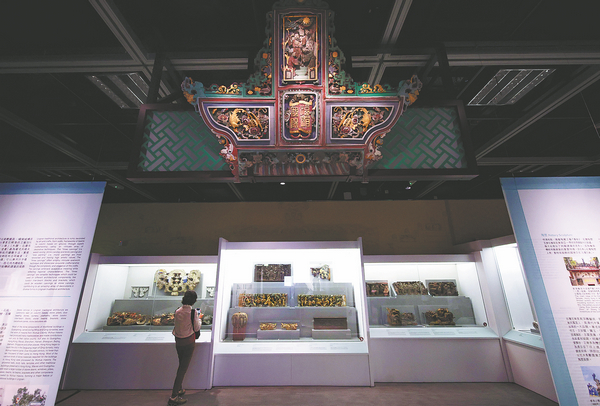
The exhibition features invaluable items and a shrine considered as a national treasure. CALVIN NG/CHINA DAILY
Notable items include the earliest discovered green-glazed barrel tile and board tile from the Nanyue King Museum, colored glass windows and woven bamboo architectural decorative components from the Macao Museum and a carved red sandstone column base from Emperor Chenghua's reign during the Ming Dynasty (1368-1644) unearthed in Hong Kong.
During the opening ceremony, Tan Ping, director of the China Cultural Relics Exchange Center, said the exhibition delves deep into the development, origins, and artistic features of Lingnan traditional architecture, showcasing the historical process of the style, construction techniques, and influences from the cultural exchange between the northern Central Plains and Lingnan's geographical customs.
He said it presents a vivid and splendid panorama of the integrated diversity of Chinese civilization, highlighting the inter-connectedness and shared roots between Hong Kong, Macao, and the motherland.
Tan further said, "Hong Kong and Macao play an inseparable role in international exchange and cooperation."
Tan revealed that since the first cultural relic exhibition held by the center in the Hong Kong Special Administrative Region in 1978 — The Exhibition of Archaeological Finds of The People's Republic of China — the center has hosted over 20 themed shows in the city, with a viewership of 1.5 million people.
And Hong Kong is one of the 50 places that have hosted the 430 cultural exhibitions by the center since its inception.
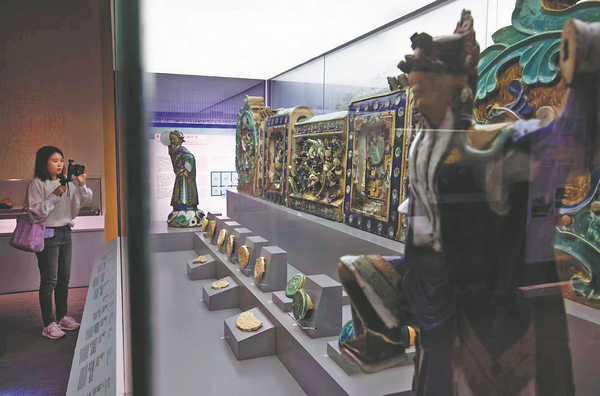
The exhibition features invaluable items and a shrine considered as a national treasure. CALVIN NG/CHINA DAILY
Bernadette Linn Hon-ho, secretary for development, says this exhibition is an important project jointly conceived, planned, and promoted by the Development Bureau and the National Cultural Heritage Administration, bringing together cultural resources from the Guangdong-Hong Kong-Macao Greater Bay Area.
She adds that it is the first project following the signing of two significant documents last year: a framework agreement to further promote cultural heritage exchange and collaboration on archaeology and built heritage between the mainland and Hong Kong, as well as a MOU between Hong Kong, Macao and Guangdong to jointly promote a culturally vibrant Bay Area under the Outline Development Plan for the Guangdong-Hong Kong-Macao Greater Bay Area.
Linn says that the exhibition's title reflects the continuity between the Lingnan traditional architectural culture in the Greater Bay Area and the Central Plains culture, embodying the integrated diversity of Chinese culture.
Copyright © Foreign Affairs Office of Guangzhou Municipal Government,
Hong Kong and Macao Affairs Office of Guangzhou Municipal Government All rights reserved.
Presented by China Daily.
京ICP备13028878号-28



